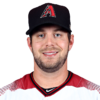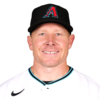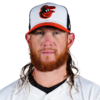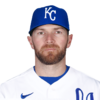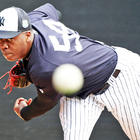2016 Fantasy Baseball Draft Prep: All 30 closer situtations ranked
Picking your Fantasy closers is complicated, and team contexts matter. Al Melchior breaks down and ranks all 30 teams in terms of their Fantasy closer situations.

The search for saves is a key part of Draft Day success for many owners, and it's a complex chore. First, we have to decide how much we want to invest by way of draft picks and auctions, and how much of our quest for saves we will leave to the vagaries of the waiver wire.
Then there is the evaluation of the relievers themselves. More so than for any other position, owners have to consider the team context in sizing up the value of each closer candidate. It's important to pay an appropriate price for the skill set you're getting, but those skills won't matter much if the team's closer situation is in flux.
These rankings aren't just rankings of the closers, but of the 30 closer situations in the majors. It's a slight departure from a straightforward ranking of closers, because a few teams have several viable candidates, and others have closers-in-waiting who could impact an incumbent's value. So, for example, either A.J. Ramos or Carter Capps could be worth pursuing as a top 12 closer, but because neither has the job nailed down for the Marlins, the situation as a whole is not one of the 12 best for Fantasy purposes.
So here is every MLB closer situation ranked from a Fantasy perspective, from least to most desirable, as we head into the early days of spring training.
30. Reds (projected closer: J.J. Hoover)
Many of the teams near the bottom of these rankings have unsettled closer situations, and the Reds are no exception, though they do have a clear front-runner. They have a ninth-inning void with the departure of Aroldis Chapman, and manager Bryan Price has stated that it's "Hoover's job to lose." After back-t0-back subpar seasons, Hoover, in fact, looks like a strong candidate to lose the job, even if he fends off the likes of Jumbo Diaz and Tony Cingrani coming out of spring training.
29. Padres (projected closer: Fernando Rodney)
There's a reason why Rodney was unceremoniously dumped from the closer's role in Seattle last summer, so it's curious that the Padres are giving him a second chance. He is simply too wild and wasn't fooling many hitters last season. Rodney did have a nice little resurgence after joining the Cubs, but those 12 innings in lower-leverage situations shouldn't be enough to give you the courage to draft him.
28. Mariners (projected closer: Steve Cishek)
Cishek is a clear downgrade from departed Carson Smith, and it's not clear he will be all that much better than Rodney was. On the surface, Cishek got better once traded from the Marlins to the Cardinals; he posted a 2.31 ERA with St. Louis. However, a 1.54 K/BB ratio suggests that he could easily turn the job over to perpetual closer-in-waiting Joaquin Benoit or rookie Tony Zych.
27. Brewers (projected closer: Will Smith/Jeremy Jeffress)
The Brewers did Fantasy owners a favor by announcing that the closer competition would come down to Smith and Jeffress, but it would still help to know who would be the front-runner. According to SportsLine and Steamer projections, Smith is the presumed closer, but Jeffress has also made a strong case for consideration. Because of the uncertainty around the pecking order, I can't trust either of them on Draft Day, but if a clear front-runner emerges he could be draftable as a No. 2 RP.
26. Phillies (projected closer: David Hernandez)
Hernandez had a solid comeback campaign with the Diamondbacks in 2015 -- his first year back from Tommy John surgery. However, it wasn't so strong as to make him an obvious closer candidate. He doesn't have much competition for the role, though, and if he returns to peak form, he could be serviceable in standard mixed leagues.
25. Braves (projected closer: Jason Grilli)
If these were Twitter handle rankings, @GrillCheese49 would rank at the top, but the 39-year-old hurler resides substantially lower on this list. He actually had an impressive comeback season in 2015 -- that is, until he tore his Achilles. Not only is he coming off that injury, but his age and recent inconsistency makes him risky, and Arodys Vizcaino showed late last season that he is a perfectly viable replacement.
24. Blue Jays (projected closer: Drew Storen/Roberto Osuna)
In acquiring Storen this offseason, the Blue Jays messed up a perfectly nice closer situation. Osuna was effective as a rookie closer and would be in the discussion for No. 1 RP options if he were assured of the job. Either reliever should be fine as a closer, though Storen's late-season struggles -- albeit, in a setup role -- are cause for some mild doubts.
23. Nationals (projected closer: Jonathan Papelbon)
The good news for Papelbon is that there is no chance he will have to compete with Storen for save opportunities, now that his former setup man is a Blue Jay. The bad news is that he has lost ground as a strikeout pitcher over the last three years, just when strikeout rates were surging throughout the major leagues. Papelbon has gotten away with it so far, but at age 35, he is operating on an increasingly thin margin of error. If I do draft Papelbon in deeper leagues, I'm certainly targeting Shawn Kelley as his handcuff.
22. Rays (projected closer: Brad Boxberger)
While Kevin Cash made noises about spreading the save opportunities around, Boxberger had a strong grip on the closer's role all season, collecting 41 of the Rays' 60 saves. Yet if Cash wants to look at all of his options, Boxberger has given him good reason to with last season's performance. He was wild (4.6 BB/9), homer-prone (1.3 HR/9) and struck out less than a batter per inning in the second half.
21. Giants (projected closer: Santiago Casilla)
I was a downer on Casilla last season, and he turned out to be just fine. While he converted 38 of 44 save chances, his peripherals still weren't overwhelming for a closer. Sergio Romo's, on the other hand, would have been very good for a closer, so he still looms as a potential replacement should Casilla struggle. Hunter Strickland wasn't bad either, so Casilla could be vulnerable despite a successful 2015 campaign.
20. Diamondbacks (projected closer: Brad Ziegler)
Even though he is no one's idea of a strikeout pitcher, I would have had Ziegler a little higher in these rankings if the Diamondbacks hadn't signed Tyler Clippard. While Ziegler should reprise his role as Arizona's closer, having Clippard around could make it easier for manager Chip Hale to pull the plug if he struggles. Though Ziegler doesn't get strikeouts, between his 70 percent-plus ground ball rate and decent control, he should have no problem getting saves.
19. Tigers (projected closer: Francisco Rodriguez)
Like Papelbon, Rodriguez doesn't throw as hard as he used to, but he is still a reliable source of strikeouts. He has also made substantial reductions in his BB/9 ratio in three consecutive seasons, carving it down from 3.9 in 2012 to 1.7 last year. Rodriguez shouldn't face any serious competition for the role unless he has a complete and utter meltdown. He has been extremely homer-prone in the past, so that is not completely unthinkable, but it's also not an especially likely scenario.
18. Athletics (projected closer: Sean Doolittle)
If Doolittle can rebound to his 2014 level of performance, he could wind up being a top 10 closer, but first he has to prove to Fantasy owners that he is all the way back from a tear in his rotator cuff. His performance late last season was encouraging, but a cautious approach is still warranted. Also, the A's brought in former closers Ryan Madson and John Axford for depth ... and possibly insurance.
17. Rockies (projected closer: Jake McGee)
There is always concern whenever a pitcher gets traded to Colorado, but McGee's reliance on his fastball and ability to miss bats just might allow him to thrive at high altitude. A bigger worry is McGee's recovery from knee surgery and general susceptibility to injury. If he can stay healthy, McGee just might wind up being the best closer the Rockies have had to date.
16. Marlins (projected closer: A.J. Ramos/Carter Capps)
The Marlins will have a reliable closer, regardless of whether Capps or Ramos wins the job. Because manager Don Mattingly has opened up the role to a competition, it makes drafting either candidate risky. That said, I'm fine with taking the risk of targeting Capps as my second reliever in mixed leagues. Ramos is good, but Capps is downright elite when healthy. It's hard to see him losing out to Ramos, and given that the Marlins are making their incumbent compete after a successful 2015 season suggests that they see Capps as a special pitcher.
15. Rangers (projected closer: Shawn Tolleson)
Tolleson settled in nicely as the Rangers' closer last season, though he faded badly enough down the stretch that he was passed over for save chances in the postseason. That doesn't necessarily mean that Tolleson will go back to a setup role, but it does show manager Jeff Banister's willingness to experiment with his ninth-inning options. Tolleson fits the profile of a closer better than Casilla or Ziegler, but clearly his grasp on the job is not as strong as that of Glen Perkins or Huston Street, both of whom are ranked just a little higher.
14. Cubs (projected closer: Hector Rondon)
Rondon made it difficult for manager Joe Maddon to go with a closer committee, as he staved off challenges from Pedro Strop and Jason Motte. He converted 30 saves, posted a 1.67 ERA and notched 69 strikeouts in 70 innings -- perfectly good numbers for a No. 2 reliever. Maddon's occasional reluctance to commit to a closer makes Rondon a bit risky, even if he performs well, though the Cubs lack a clear alternative.
13. Twins (projected closer: Glen Perkins)
Perkins' final stat line from 2015 (3.32 ERA, 1.19 WHIP, 32 saves) was not all that impressive, but back issues were likely responsible for a poor late-season performance. Granted, this was the second season in a row in which Perkins got hurt late in the year and struggled on the mound as a result. While he has to be considered a health risk, he continues to be effective when not nagged by injuries.
12. Angels (projected closer: Huston Street)
While he is not among the better strikeout pitchers in the closer corps, Street can still get it done, and the Angels don't have a clear successor. The Angels' offense looks sketchy to say the least, but the starting pitching could be good enough to provide plenty of close contests -- and save opportunities for Street. He may not throw hard, but he is still very good at getting swings and misses, so that offers hope that Street might rebound as a source of strikeouts.
11. Astros (projected closer: Ken Giles)
Based on his work with the Phillies last season, Giles deserves to be a few spots higher in these rankings. When the Astros traded for him this offseason, and gave up a hefty haul in the process, it was logical to conclude that they would use Giles as their closer, but manager A.J. Hinch has to yet to commit to going with the 25-year-old over incumbent Luke Gregerson. That bit of uncertainty keeps Giles out of the top 10.
10. Pirates (projected closer: Mark Melancon)
After finishing 2015 as the top-ranked reliever in Fantasy, Melancon has to get props as a top-10 closer. Then again, much of Melancon's value came from his major league-leading 51 saves. He can't count on being provided with as many save chances again this season, and his declining K-rate could eventually catch up with him.
9. Cardinals (projected closer: Trevor Rosenthal)
Rosenthal's second year as the Cardinals' full-time closer went much better than the first. In racking up 48 saves, Rosenthal shaved an unsightly 5.4 BB/9 to a respectable 3.3. That helped him to reduce his ERA by more than a run and his WHIP by 14 points. Rosenthal could still stand to have better control, but he should be good enough to keep Kevin Siegrist and Jordan Walden in setup roles.
8. Indians (projected closer: Cody Allen)
Allen is also a bit control-challenged, but his extraordinary ability to miss bats allows him to perform like a solid mixed league closer. Coming off a season in which he posted a 3.8 percent home run to flyball ratio, Allen does have the look of a regression candidate, but he could still be a lower-end No. 1 reliever.
7. Mets (projected closer: Jeurys Familia)
Familia made huge strides last season, finding his control, pushing his ground ball rate above 60 percent and getting whiffs on 17.3 percent of his pitches. He may not have the extended track record of success that Chapman or Craig Kimbrel has, but if 2015 is any indication, Familia has reached the ranks of the elite closers.
6. White Sox (projected closer: David Robertson)
Robertson is probably going to be one very underrated closer on Draft Day. With a 3.41 ERA in 2015, Robertson wasn't a great run-preventer, and his seven blown saves in 41 tries shows that he paid a price. Yet Robertson's 0.93 WHIP reflects that he was stingy with hits and walks. His 67 percent strand rate looks like an outlier, and as long as he keeps getting swinging strikes, Robertson should be one of the top relievers in Fantasy.
5. Yankees (projected closer: Aroldis Chapman)
Among closers, Chapman's on-the-field résumé over the past four years has been equalled only by that of Kimbrel, and he has been unequaled as a strikeout pitcher. Still, Chapman is some distance from being one of the two most trustworthy relievers in this year's drafts. The possibility of him serving a suspension for violating MLB's domestic violence policy is reason enough to downgrade him on Draft Day. While some may view his move to the Yankees as a positive, the presence of two other elite relievers -- Andrew Miller and Dellin Betances -- in their bullpen makes his hold on the closer's job less than totally secure.
4. Orioles (projected closer: Zach Britton)
Chapman and Kimbrel may have the best long-term track records, but Britton is on the best trajectory. He was neck-and-neck with Chapman and Kimbrel in Fantasy value last season, finishing with more Fantasy points than Chapman and more Rotisserie value than Kimbrel. Britton actually put up a higher swinging strike rate than Kimbrel in 2015, and while he still lagged behind Chapman in that regard, he is the far superior control pitcher. Then there's that 81 percent ground ball rate. Britton is ridiculously underrated, and even with the return of Darren O'Day, he doesn't have any real competition for the closer's role.
3. Dodgers (projected closer: Kenley Jansen)
Jansen has been steady as one of the elite closers over the last four seasons, but he has much more going for himself than just consistency. Last year, he was just behind Chapman and Miller in strikeout rate, and he blew away the field of relievers with a strikeout-to-walk rate differential of 36.0 percent. Based on skills alone, Jansen may be the best reliever in Fantasy right now, but the Dodgers may need some convincing of that, given their pursuit of Chapman this offseason. It doesn't seem like Jansen's job is in jeopardy now, but the Dodgers' wavering commitment acts as a tiebreaker, placing him just below the top two closing options in Fantasy.
2. Red Sox (projected closer: Craig Kimbrel)
Last season was an off year for Kimbrel, but it's all relative. In his only year as a Padre, Kimbrel continued to be one of Fantasy's top strikeout relievers, but he uncharacteristically veered towards a normal BABIP rate with a .276 mark. He probably won't allow a 31 percent line drive rate again this year. Koji Uehara and Carson Smith have proven they can close, too, but don't expect them to be a threat to Kimbrel's job security in Boston.
1. Royals (projected closer: Wade Davis)
Davis often gets left out of the discussions of great closers, because he has only been doing it on a full-time basis since last September. He was utterly dominant as Greg Holland's setup man in 2014, and he did his fair share of filling in as the Royals' closer last season, and all he did was limit opponents to a .451 OPS. Granted he had some BABIP help (.203), but Davis simply doesn't allow much hard contact. Davis presents the best combination of elite performance and job security, now that he has inherited the closer's role with Holland needing all of 2016 to recover from Tommy John surgery.

